NDVI stands for "Normalized Difference Vegetation Index". NRG stands for "Near-infrared / Red / Green". NDVI and NRG are both ways to visualize the amounts of infrared and other wavelengths of light reflected from vegetation. Because both these methods compare ratios of blue and red light absorbed versus green and IR light reflected, they can be used to evaluate the health of vegetation. It's a snapshot of how much photosynthesis is happening. This is helpful in assessing vegetative health or stress. (Read more here: https://www.agronomy.org/publications/jeq/articles/36/3/832) ## Do-It-Yourself These techniques for vegetation analysis were developed for satellite imagery, but at Public Lab, we've been working a lot on capturing infrared imagery using our DIY [near-infrared camera](/wiki/near-infrared-camera) setup, and combining it with visible bands to produce NDVI images such as the one above. ## What these images mean What exactly are these images we're trying to make? What do they tell us about vegetation, and why? These diagrams should help to understand what it is we're doing and why these are good ways to analyze plant life. ## The NDVI equation [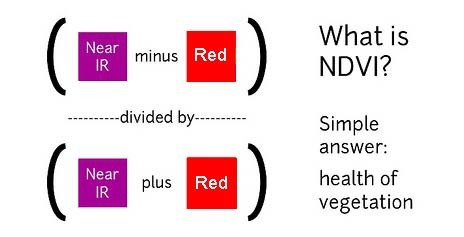](/i/44723) **NDVI = (Near Infrared - Red)/(Near Infrared + Red)** NDVI is a ratio which tries to emphasize photosynthesis while filtering out sun glare. The above equation is run for every pixel, using source data from an infrared photo and a visible light photo, like this pair: [](https://publiclab.org/system/images/photos/000/021/771/original/5390895115_c9d4d38fec_o.jpg) The result can be false-colored to make the high-photosynthesis areas more clear, and used to examine where plants are and how healthy they are. [](https://publiclab.org/system/images/photos/000/021/770/original/PetVISNDVIcomp.png) _Figure above: Normal color photo (right) and normalized difference vegetation index (NDVI) image (left). NDVI image was derived from two color channels in a single photo taken with a camera modified with a special infrared filter. Note that tree trunks, brown grass, and rocks have very low NDVI values because they are not photosynthetic. Healthy plants typically have NDVI values between 0.1 and 0.9. -- @cfastie_ ### Activities Here are a range of activities you can do to produce and interpret your own NDVI imagery, whether downloaded from a satellite imagery provider or [collected yourself using a DIY technique](/wiki/multispectral-imaging) [activities:ndvi] ****   Most DIY converted cameras today (those from Public Lab) use RGN instead of NRG, so the blue channel represents infrared instead of the red channel. That looks like this: [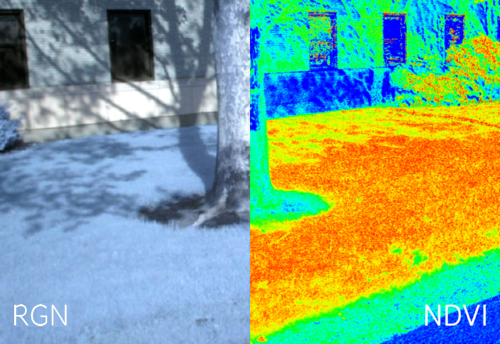](/i/45468?s=o) **** ## NRG imagery Some people are also interested in producing NRG imagery (like the below image), where `Near-Infrared, Red, and Green` are used to compose a picture instead of the usual `Red, Green, and Blue`. [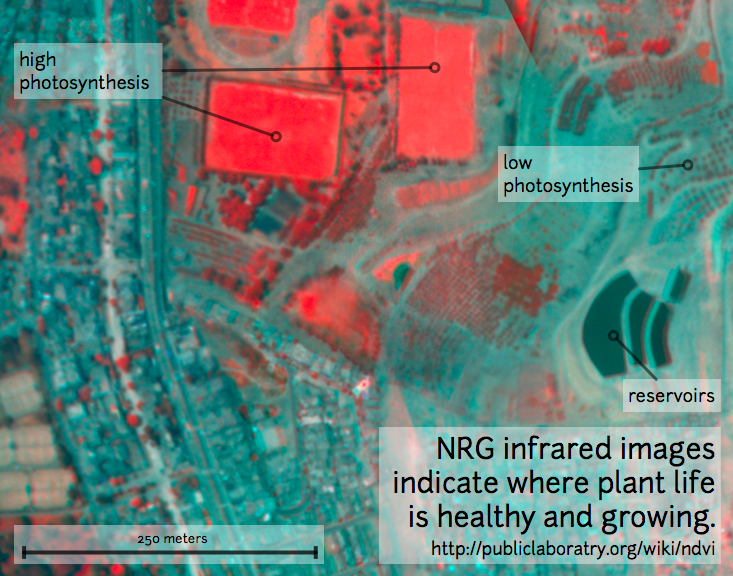](/i/25064) This diagram explains the swapping, which allows us to 'see' infrared as if it were a normal color: [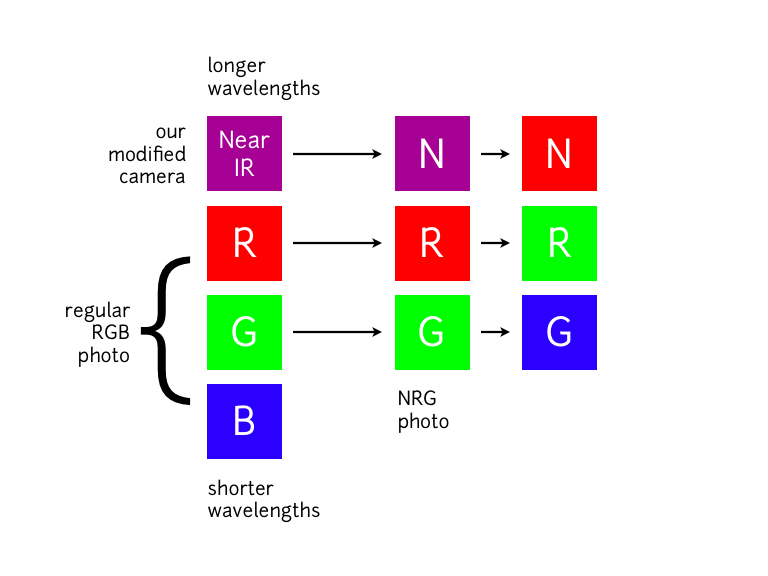](/i/25063) **In NRG images, the deeper and clearer the red color, the denser and healthier the vegetation (more or less).** ### Questions [questions:ndvi] ### Other examples of DIY NDVI imaging From around the internet: Begin watching at 2 minutes to see the resulting imagery: *This topic is part of the [Grassroots Mapping Curriculum](/wiki/mapping-curriculum) series.* **** [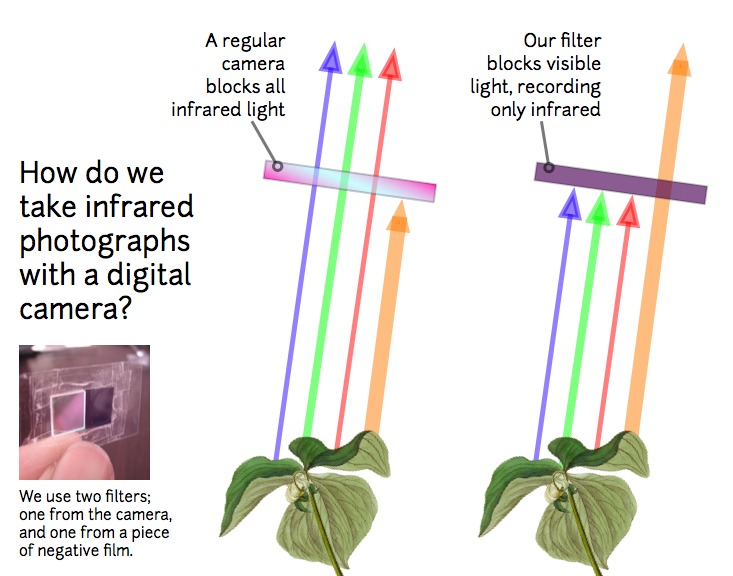](/i/25066) [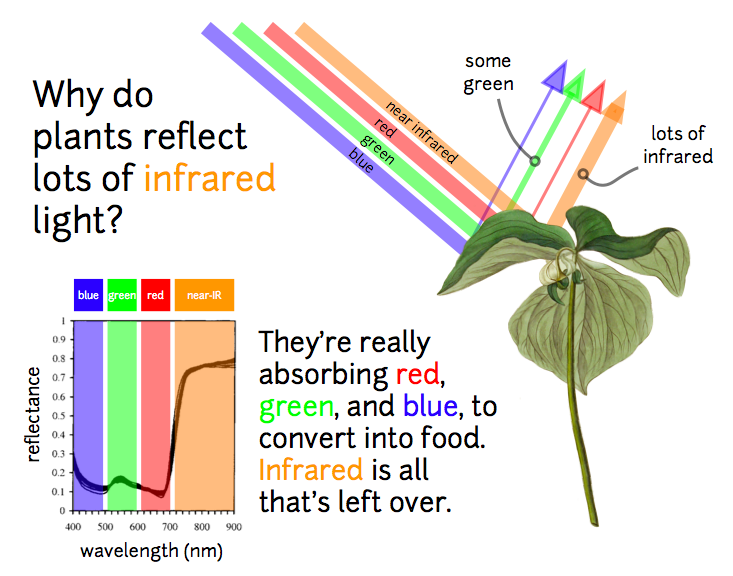](/i/25065) ...
| Author | Comment | Last activity | Moderation | ||
|---|---|---|---|---|---|
| cfastie | "Even with that nice filter it won't be possible to get a pure red channel. The red channel is sensitive to NIR light, and NIR is transmitted by the..." | Read more » | over 7 years ago | |||
| aldrin | "Thank you, so much. I'm planning to use DB660/850 which is a Dual Bandpass filter for NIR and VIS. I understand that if I use it, I can Get Red+NIR..." | Read more » | over 7 years ago | |||
| warren | "Hi - would you mind making the title "How can i validate that the data I obtained using raspi noir camera are really NIR and NDVI?" so it's easier ..." | Read more » | over 7 years ago | |||
| cfastie | "Depending on the blue filter used, photos from a Pi NoIR camera would capture (instead of R,G,B) NIR+R, NIR+G+B, B+NIR+G. If you use a good red fil..." | Read more » | over 7 years ago | |||
| nachokhan | "Hey, interesting. I am also from Argentina and I am working in the same field. Can you write me? ignacio.rigoni at gmail. Abrazo! " | Read more » | over 8 years ago | |||
| cfastie | "It will probably be possible to give you some guidance if you attach a couple of the photos straight from the camera. Chris " | Read more » | almost 9 years ago | |||
| agustin_castellano | "Hi Andresc4, i would like be in touch with you.i'm researching about the same like you. I live in Argentina. Please contact me my emailagustin.cast..." | Read more » | almost 9 years ago | |||
| warren | "Note: the python library is here: https://github.com/publiclab/infrapix Infragrammar would be great to adopt as a standard: http://publiclab.org/w..." | Read more » | about 9 years ago | |||
| cfastie | "Andresc4, The A2300 allows custom white balance. For a red or yellow filter, flood the sensor with red light (fill the frame with red paper in dire..." | Read more » | about 9 years ago | |||
| andresc4 | "cfastie Great, in that case the formula that I'm using is correct for the Weatten25A or for the Yellow filter ndiv= (ndiv.b-ndiv.r)/(ndiv.b+ndiv...." | Read more » | about 9 years ago | |||
| cfastie | "The response from Pix4D does not seem to be well informed. With a Wratten 25A filter, NIR and little else will be captured in the blue channel and ..." | Read more » | about 9 years ago | |||
| andresc4 | "Another thing that confuses me a little bit more is this response from the people of Pix4d Pix4D Support December 01, 2014 13:28 Dear Andres, We..." | Read more » | about 9 years ago | |||
| warren | "One way to do this could involve the python version of infragram -- perhaps modded to use Infragrammar? " | Read more » | about 9 years ago | |||
| natalie | " " | Read more » | almost 10 years ago | |||
| natalie | "What about a different filter? Or how do we white balance these? Next Steps suggestions. " | Read more » | almost 10 years ago | |||
| warren | ":-/ doesn't look good. I think without white balancing it, we're going to have a hard time using this cam. http://infragram.org/i/53f266c40ab503..." | Read more » | almost 10 years ago | |||
| natalie | " The plant is dying but it still have some green to it. How is this? " | Read more » | almost 10 years ago | |||
| warren | "Mathew just had trouble uploading lots of photos too, so perhaps it chokes on large uploads. If you could just upload the one raw image with a red ..." | Read more » | almost 10 years ago | |||
| natalie | "I guess. What a pain in the butt. I tried for about an hour to post them at the original size and the wiki just said updating, perpetually and neve..." | Read more » | almost 10 years ago | |||
| mathew | "There's an application for linux-- GUVCView that should let you capture full resolution 1200x1600) in the settings. " | Read more » | almost 10 years ago | |||
| warren | "Hi, Natalie - thanks for updating, but your photos are really tiny -- is there any way you can post them at full resolution? They look promising, b..." | Read more » | almost 10 years ago | |||
| natalie | "Okay check out my updates. @warren, @mathew, @cfastie " | Read more » | almost 10 years ago | |||
| warren | "Here are the notes and test photos from when we originally chose the current webcam http://publiclab.org/notes/warren/09-08-2013/infragram-webcam-..." | Read more » | almost 10 years ago | |||
| mathew | "white balance is tough-- I only remember control of exposure in UVC. look at these programs: http://publiclab.org/wiki/spectral-workbench-usage#We..." | Read more » | almost 10 years ago |